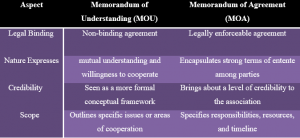The discipline of International Relations researches the different manners through which sovereign countries interact with each other. Regardless whether the interaction is defined by cooperation or repulsion, 193 states of the United Nations (UN) are understood to inscribe a set of diplomatic tools that guide the operation through. In this regard, the intercountry relations are never arbitrary and are subject to particular forms of protocols that govern the entirety of this vital operation. From a simplistic point of view, it is a form of resonance between countries based on the mutual benefits that can be extracted from working together towards a well-defined objective. In order to reap a minute understanding of the hierarchical shape of the diplomatic relations, it is mandatory to evince an accurate display of the different diplomatic agreements that define the international relations.
A well-known form of collaboration is the signing of the agreements. The latter could translate the understanding between two political entities or instances in one-to-one terms, more formally referred to as a “bilateral agreement”. It can also reflect harmony between more than two parties, referred to as a “multilateral agreement”. On a general note, Harvard University defines the “memorandum” (pl., memoranda) as a “written statement on any subject, generally routine, from the Department of State or Ministry of Foreign Affairs to an embassy or legation” (Diplomatic Communications, n.d.). In actuality, when it comes to demystifying the blurriness of the memorandum, it is possible to distinguish two types of diplomatic bindings, namely, the MOA and the MOU. Notwithstanding, it is vital to indicate that these categories of documents are classified in the international law under the umbrella of “Treaties” within the United Nations.
Colloquially referred to as MOA, the “Memorandum of Agreement” is better known to encapsulate strong terms of entente among the relevant undertakers. It is viewed as a legally enforceable type of agreement that brings about a level of credibility to the bilateral/multilateral association. Moreover, the MOA is positively assessed by international observers mainly because it implements a touch of earnestness to the attachment. It reduces the scope as well as the duration of the agreement. As a matter of fact, it highlights a number of well-specified criteria exemplified in the responsibilities of each party, the resources involved, the timeline as well as the financial commitments of each of the signatories.
The “Memorandum of Understanding”, briefly referred to as an MOU is another important form of diplomatic cooperation between countries. In fact, engaging in a similar process englobes some advantages as well as some drawbacks. It is important to keep in mind that one of its distinctive features is that it is a non-binding agreement between two or more parties and it, therefore, is dependent on the intent of the signatories in question. To put it simply, it cannot exceed outlining their mutual understanding and willingness to collaborate to reach together specific issues or areas of cooperation. While an MOU is not legally binding like a treaty, it serves as a formal document that expresses the parties’ intention to collaborate and sets the framework for further negotiations or actions. Last but not least, an MOU is commonly depicted as a more formal conceptual framework than a gentlemen’s agreement within which only intentions are convergent and none of the jurisdictions is enforced.
In order to make clear the differences and help the reader reach a good understanding, please refer to the below table.

Marwene Ben JANNENA
REFERENCES
- Diplomatic Communications. (n.d.). https://projects.iq.harvard.edu/files/hks-communications-program/files/pp_sri_kulkarni_and_yotam_goren_4_10_17.pdf.



















































